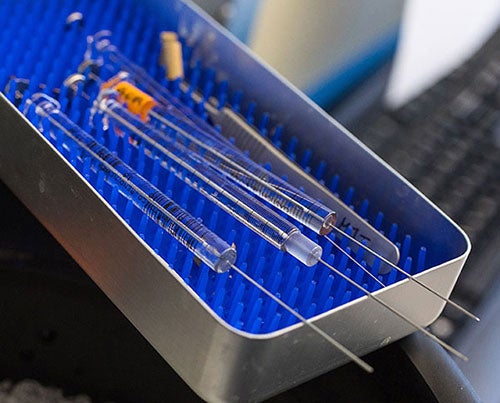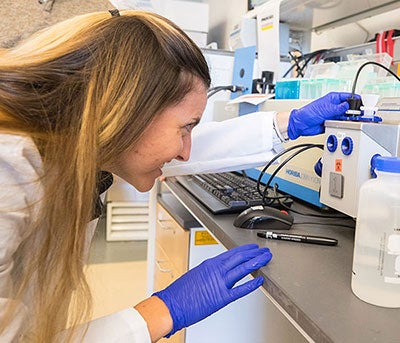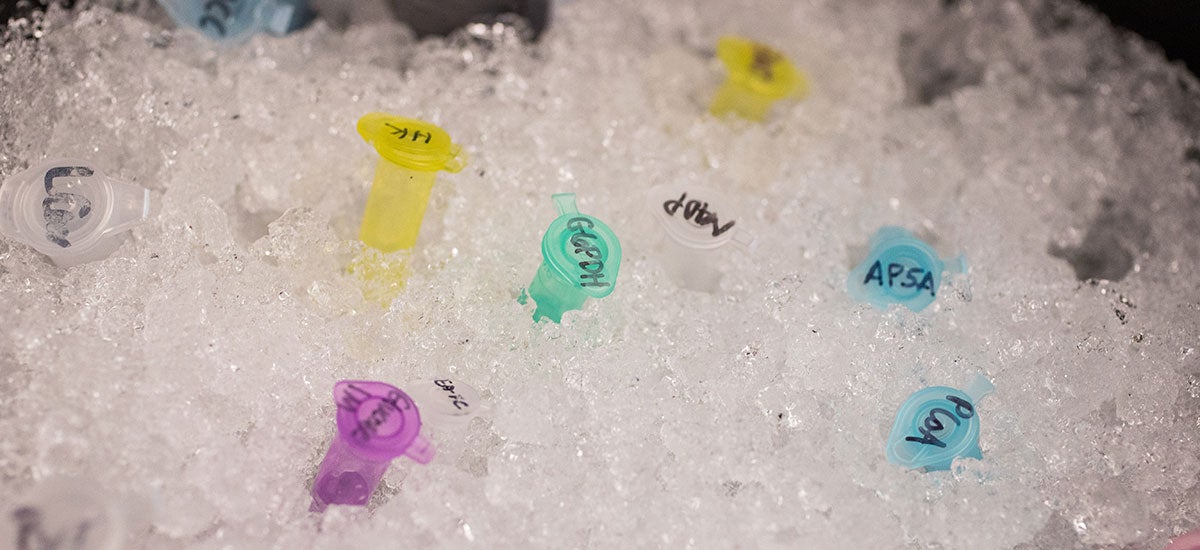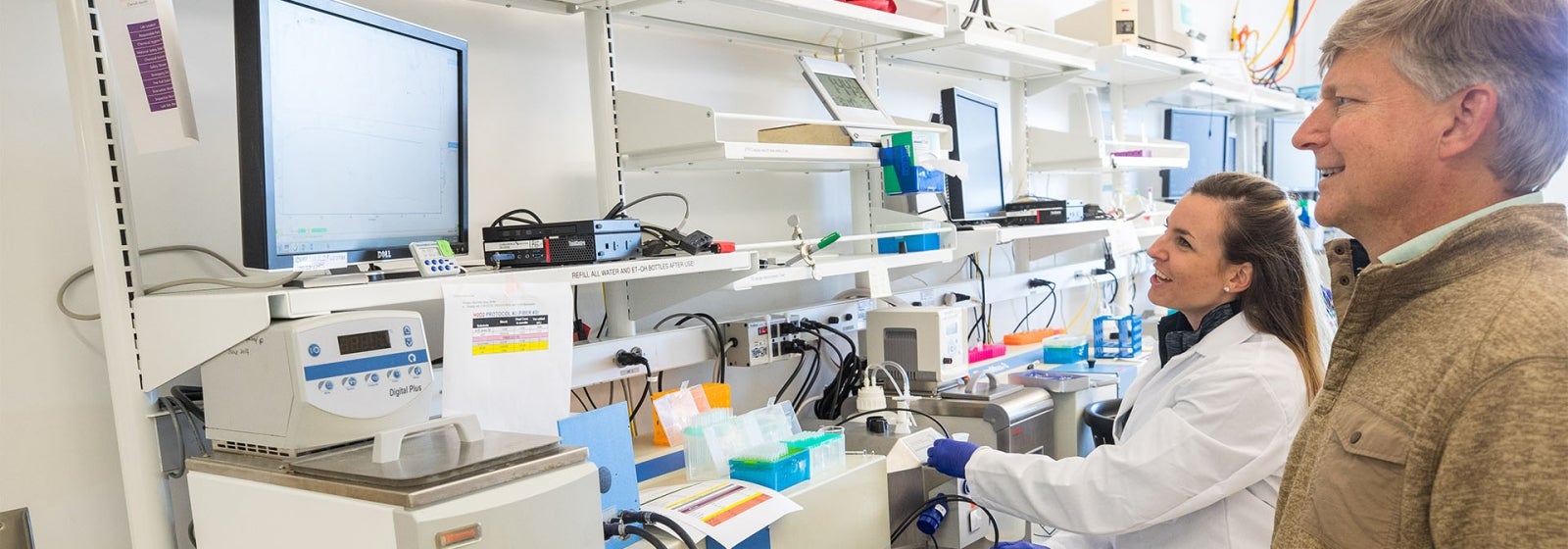WORTH THE WAIT
Estrogen research breaks new ground in women’s health
Dr. Maria Torres has remained at East Carolina University for nearly a year since earning her doctorate last December to finish her research project, which has now been published and is poised to alter our understanding of how estrogen works in the body.
The paper, which helps explain why menopause increases susceptibility to weight gain, insulin resistance, and the risk for diabetes and cardiovascular disease, has been accepted for publication in Cell Metabolism, one of the most prestigious journals in the field.
Torres, who came from Uruguay to ECU to pursue her Ph.D. in bioenergetics and exercise science, said her experience as a fitness instructor contributed to her interest in the topic. Women would ask her why they were gaining weight after menopause, when their diet and exercise routines had not changed.
“It was something that always intrigued me, and I couldn’t tell them. I didn’t have a good answer for it,” she said.

Torres’ research on the role of estrogen in mitochondrial function has important implications for women’s health.
After years of research and hard work under the tutelage of Dr. Darrell Neufer, director of the East Carolina Diabetes and Obesity Institute, she’s one big step closer to having that answer.
“It provides an intriguing potential explanation as to why loss of estrogen due to menopause or surgery alters a woman’s metabolism and increases the risk for developing obesity and diseases that stem from metabolic imbalance,” said Neufer.
“There has been evidence for decades that estrogen modulates metabolism in different ways, but we never really knew the entire story,” said Torres.
When a woman’s ovaries stop producing estrogen, it can lead to metabolic disease and higher risk for Type 2 diabetes and cardiovascular disease, as well as weight gain.
We know that “the loss of estrogen brings problems in metabolism, and if we replace it (through hormone therapy), it helps, but it’s not really the most suitable treatment for every woman,” Torres said. “So we wanted to answer the question, what is estrogen doing in our metabolism on a molecular basis? What’s happening when it’s gone, what’s happening when it’s put back, and how is it affecting our metabolism?”
Torres’ research centered on the role of estrogen in mitochondrial function. Mitochondria are the engines of the cell, turning energy from food into a form that the cell can use. Her project shows that estrogen is a component of the mitochondrial membrane and that its presence improves the efficiency of mitochondrial function.

Cell Metabolism, one of the most prestigious journals in the field, has published Torres’ work.
“One of the things we found is that estradiol, the main female sex hormone, can get incorporated in mitochondrial membranes,” Torres said. When it’s there, it makes the membrane more fluid, allowing the mitochondria to operate more efficiently. Torres likened it to using better oil in the engine of your car.
“The flow of energy through that engine depends on a lot of components,” she said. “If something goes wrong in that engine, if some of those components are not OK, you lose efficiency, you lose performance, you get a dark exhaust coming out of your car.
“In the body that translates to insulin resistance and weight gain.”
The findings are a departure from the classical understanding of the role of estrogen in metabolism, in that the hormone exerts functions independent of estrogen receptors, altering the biophysical properties of the mitochondrial membrane.
The project has important implications for the development of better therapies, said Torres. “Menopausal hormone therapies are used with caution, as they have certain risks, and are not suitable for every woman. Understanding exactly how these hormones modulate bioenergetics is key for the development of safer, and potentially tissue-specific pharmacological interventions, to prevent metabolic imbalance.”
The publication of the paper in Cell Metabolism is the culmination of five years of research; it was the subject of Torres’ doctoral dissertation and almost a full year of post-doc research. She credits Neufer for encouraging her to aim high, combining what could have been as many as three less-comprehensive papers into one with a greater impact.
Torres has presented her work at several national conferences, including meetings of the American Physiological Society, where it has been well received. As an advocate for women’s health, she said she is excited to contribute to the field and shed light on an area where there is a gap in scientific understanding.
“Working on this floor helped tremendously,” she said of the ECDOI, located on the fourth floor of the East Carolina Heart Institute. “I got to collaborate with Dr. (Saame Raza) Shaikh and Dr. (Tonya) Zeczycki, and they all brought a little bit extra, and it just kept growing into this amazing paper. I’m definitely thankful for all the opportunities that I had here, and for the Neufer lab.”
Torres will head to Duke University to pursue a new post-doctoral project in the coming months.
The full Cell Metabolism article is available here.

Samples chill in the lab.
